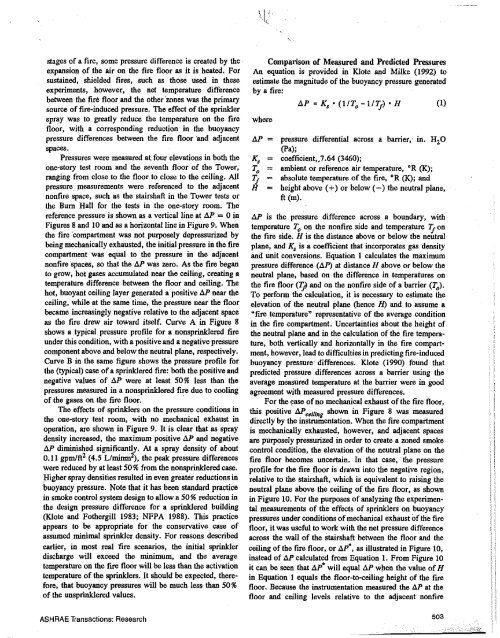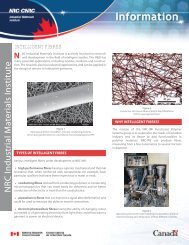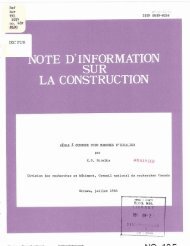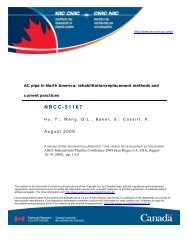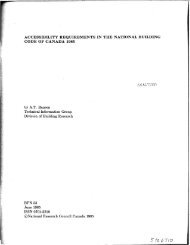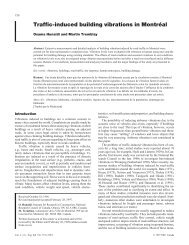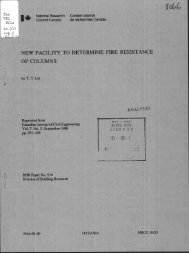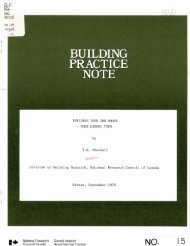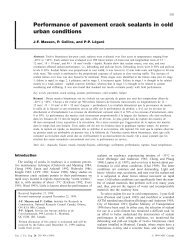Effect of Automatic Sprinkler Protection on Smoke Control Systems
Effect of Automatic Sprinkler Protection on Smoke Control Systems
Effect of Automatic Sprinkler Protection on Smoke Control Systems
Create successful ePaper yourself
Turn your PDF publications into a flip-book with our unique Google optimized e-Paper software.
stages <str<strong>on</strong>g>of</str<strong>on</strong>g> a ftre, some pressure difference is created by theexpansi<strong>on</strong> <str<strong>on</strong>g>of</str<strong>on</strong>g> the air <strong>on</strong> the fire floor as it is heated. Forsustained, shielded fires, such as those used in theseexperiments, .however, the net temperature differencebetween the fire floor and the other 'z<strong>on</strong>es was the primarysource <str<strong>on</strong>g>of</str<strong>on</strong>g> fire-induced pressure. The effect <str<strong>on</strong>g>of</str<strong>on</strong>g> the sprinklerspray was to greatly reduce the temperature <strong>on</strong> the firefloor, with a corresp<strong>on</strong>ding reducti<strong>on</strong> in the buoyancypressure differences between the fire floor Md adjacentspaces.Pressures were measured at four elevati<strong>on</strong>s in both the<strong>on</strong>e-story test room and the seventh floor <str<strong>on</strong>g>of</str<strong>on</strong>g> the Tower,ranging from close to the floor to close to the ceiling. Allpressure. measurements were referenced to the adjacentn<strong>on</strong>fire space, such as the stairshaft in the Tower tests orthe Bum Hall for the tests in the <strong>on</strong>e-story room. Thereference pressure is shown as a vertical line at AP = 0 inFigures 8 and 10 and as a horiz<strong>on</strong>tal line in Figure 9; Whenthe fire ·compartment was not purposely depressurized bybeing mechanically exhausted, the initial pressure in the firecompartment was equal to the pressure in the adjacentn<strong>on</strong>fire spaces, so that the t.P was zero. As the fire beganto grow, hot gases accumulated near the ceiling, creating atemperature difference between the floor and ceiling. Thehot, buoyant ceiling layer generated a positive AP near theceiling, while at the same time, the pressure near the floorbecame increasingly negative relative to the adjacent spaceas the fire drew air toward itself. Curve A in Figure 8shows a typical pressure pr<str<strong>on</strong>g>of</str<strong>on</strong>g>ile for a n<strong>on</strong>sprinklered fireunder this c<strong>on</strong>diti<strong>on</strong>, with a positive and a negative pressurecomp<strong>on</strong>ent above and below the neutral plane, respectively.Curve B in the same figure shows the pressure pr<str<strong>on</strong>g>of</str<strong>on</strong>g>ile forthe (typical) case <str<strong>on</strong>g>of</str<strong>on</strong>g> a sprinklered fire: both the positive andnegative values <str<strong>on</strong>g>of</str<strong>on</strong>g> AP were at least SO% less than thepressures measured in a n<strong>on</strong>sprinklered fire due to cooling<str<strong>on</strong>g>of</str<strong>on</strong>g> the gases <strong>on</strong> the fire floor.The effects <str<strong>on</strong>g>of</str<strong>on</strong>g> sprinklers <strong>on</strong> the pressure c<strong>on</strong>diti<strong>on</strong>s inthe <strong>on</strong>e-story test room, with no mechanical exhaust inoperati<strong>on</strong>, are shown in Figure 9. It is clear that as spraydensity increased, the maximum positive AP and negativeAP diminished significantly. At a spray density <str<strong>on</strong>g>of</str<strong>on</strong>g> about0.11 gpm/ft2 ( 4.S Llminm2), the peak pressure differenceswere reduced by at least SO% from the n<strong>on</strong>sprinklered case.fligher spray densities resulted in even greater reducti<strong>on</strong>s in'buoyancy pressure. Note that it has been standard practicein smoke c<strong>on</strong>trol system design to allow a SO% reducti<strong>on</strong> inthe design pressure difference for a sprinklered building(Klote and Fothergill 1983; NFPA 1988). This practiceappears to be appropriate for the c<strong>on</strong>servative case <str<strong>on</strong>g>of</str<strong>on</strong>g>assumed minimal sprinkler density. For reas<strong>on</strong>s describedearlier, in most real ·fire scenarios, the initial sprinklerdischarge will exceed the minimum, and the averagetemperature <strong>on</strong> the fire floor will be less than the activati<strong>on</strong>temperature <str<strong>on</strong>g>of</str<strong>on</strong>g> the sprinklers: It should be expected, therefore,that buoyancy pressures will be much less than SO%<str<strong>on</strong>g>of</str<strong>on</strong>g> the unsprinklered values.ASH RAE Transacti<strong>on</strong>s: ResearchComparis<strong>on</strong> <str<strong>on</strong>g>of</str<strong>on</strong>g> Measured and Predicted PressuresAn equati<strong>on</strong> is provided in Klote and Milke (1992) toestimate the magnitude <str<strong>on</strong>g>of</str<strong>on</strong>g> the buoyancy pressure generatedby a fire:whereAP =K, =T. ===~t.P = K, • (I/T 0-liT!) • H (1)pressure differential across a barrier,· in. H 2 0(Pa);coefficient,7.64 (3460);ambient or reference air temperature, •R {K);absolute temperature <str<strong>on</strong>g>of</str<strong>on</strong>g> the fire, 0 R (K); andheight above ( +) or below (-) the neutral plane,ft (m).AP is the pressure difference across a boundary, withtemperature T 0<strong>on</strong> the n<strong>on</strong>fire side and temperature 1j <strong>on</strong>the fire side. H is the distance above or below the neutralplane, and K, is a coefficient that incorporates gas densityand unit c<strong>on</strong>versi<strong>on</strong>s. Equati<strong>on</strong> I calculates the maximumpressure difference (t.P) at distance H above or below theneutral plane, based <strong>on</strong> the difference in temperatures <strong>on</strong>the fire floor (Tj! and <strong>on</strong> the n<strong>on</strong>fire side <str<strong>on</strong>g>of</str<strong>on</strong>g> a barrier (T 0).To perform the calculati<strong>on</strong>, it is necessary to estimate theelevati<strong>on</strong> <str<strong>on</strong>g>of</str<strong>on</strong>g> the neutral plane (hence H) and to assume a"fire temperature" representative <str<strong>on</strong>g>of</str<strong>on</strong>g> the average c<strong>on</strong>diti<strong>on</strong>in the fire compartment. Uncertainties about the height <str<strong>on</strong>g>of</str<strong>on</strong>g>the neutral plane and in the calculati<strong>on</strong> <str<strong>on</strong>g>of</str<strong>on</strong>g> the fire temperature,both vertically and horiz<strong>on</strong>tally in the fire compartment,however, lead to difficulties in predicting fire-inducedbuoyancy pressure· differences. Klote (1990) found thatpredicted pressure differences across a barrier using theaverage measured temperature at the barrier were in goodagreement with measured pressure differences.For the r-ase <str<strong>on</strong>g>of</str<strong>on</strong>g> no mechanical exhaust <str<strong>on</strong>g>of</str<strong>on</strong>g> the fire floor,this positive AP ceiling shown in Figure 8 was measureddirectly by the instrumentati<strong>on</strong>. When the fire compartmentis mechanically exhausted, however, and adjacent spacesare purposely pressurized in order to create a z<strong>on</strong>ed smokec<strong>on</strong>trol c<strong>on</strong>diti<strong>on</strong>, the elevati<strong>on</strong> <str<strong>on</strong>g>of</str<strong>on</strong>g> the neutral plane <strong>on</strong> thefire floor becomes uncertain. In that case, the pressurepr<str<strong>on</strong>g>of</str<strong>on</strong>g>ile for the fire floor is drawn into the negative regi<strong>on</strong>,relative to the stairshaft, which is equivalent to raising theneutral plane above the ceiling <str<strong>on</strong>g>of</str<strong>on</strong>g> the fire floor, as shownin Figure 10. For the purposes <str<strong>on</strong>g>of</str<strong>on</strong>g> analyzing the experimentalmeasurements <str<strong>on</strong>g>of</str<strong>on</strong>g> the effects <str<strong>on</strong>g>of</str<strong>on</strong>g> sprinklers <strong>on</strong> buoyancypressures under c<strong>on</strong>diti<strong>on</strong>s <str<strong>on</strong>g>of</str<strong>on</strong>g> mechanical exhaust <str<strong>on</strong>g>of</str<strong>on</strong>g> the firefloor, it was useful to work with the net pressure differenceacross the wall <str<strong>on</strong>g>of</str<strong>on</strong>g> the stairshaft between the floor and theceiling <str<strong>on</strong>g>of</str<strong>on</strong>g> the fire floor, or I!..P•, as illustrated in Figure 10,instead <str<strong>on</strong>g>of</str<strong>on</strong>g> AP calculated from Equati<strong>on</strong> 1. From Figure 10it can be seen that AP• will equal AP when the value <str<strong>on</strong>g>of</str<strong>on</strong>g> Hin Equati<strong>on</strong> I equals the floor-to-ceiling height <str<strong>on</strong>g>of</str<strong>on</strong>g> the firefloor. Because the instrumentati<strong>on</strong> measured the AP at thefloor and ceiling levels relative to the adjacent n<strong>on</strong>fire503


